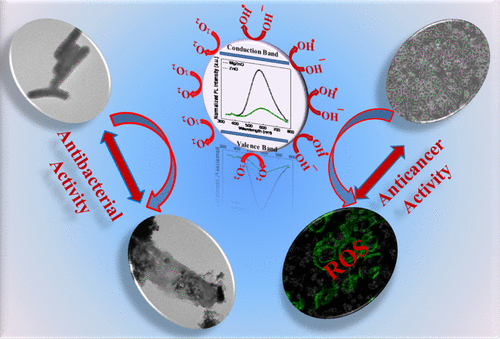Our official English website, www.x-mol.net, welcomes your feedback! (Note: you will need to create a separate account there.)
Defect-Mediated Reactive Oxygen Species Generation in Mg-Substituted ZnO Nanoparticles: Efficient Nanomaterials for Bacterial Inhibition and Cancer Therapy
ACS Omega ( IF 4.1 ) Pub Date : 2018-03-12 00:00:00 , DOI: 10.1021/acsomega.7b01953 Jagriti Gupta 1 , D Bahadur 1
ACS Omega ( IF 4.1 ) Pub Date : 2018-03-12 00:00:00 , DOI: 10.1021/acsomega.7b01953 Jagriti Gupta 1 , D Bahadur 1
Affiliation

|
Mg-substituted ZnO nanoparticles (MgZnO NPs) were synthesized by a soft chemical approach and were well-characterized by X-ray diffraction, transmission electron microscopy, UV–visible spectroscopy, and photoluminescence spectroscopy. The absorption and photoluminescence spectra show that substitution of Mg ions results in the widening of the band gap and a significant enhancement in the concentration of defects in ZnO NPs. A systemic study of generation of reactive oxygen species (ROS) under dark, daylight, and visible light conditions suggests that the aqueous suspension of MgZnO NPs generates a higher level of ROS because of the surface defects (oxygen vacancies). This capability of MgZnO NPs makes them a more promising candidate for the inhibition of bacterial growth and for killing of cancer cells as compared to pure ZnO NPs, possibly because of the enhanced interaction and accumulation of MgZnO NPs in the cytoplasm or cell membrane in the presence of both Zn2+ and Mg2+ ions. Further, MgZnO NPs exhibit excellent selective killing of nasopharyngeal carcinoma cells (KB) and cervical cancer cells (HeLa) with minimal toxicity to normal fibroblast cells (L929). The results suggest that the generation of ROS and Zn2+ ions are possibly responsible for the higher activity toward the depolarization of cell membrane potential, the lipid peroxidation in bacterial cells, depolarization of the mitochondrial membrane, and cell cycle arrest in the S phase in cancer cells.
中文翻译:

镁取代的 ZnO 纳米颗粒中缺陷介导的活性氧生成:用于细菌抑制和癌症治疗的高效纳米材料
镁取代的 ZnO 纳米粒子(MgZnO NPs)是通过软化学方法合成的,并通过 X 射线衍射、透射电子显微镜、紫外可见光谱和光致发光光谱进行了良好的表征。吸收和光致发光光谱表明,Mg 离子的取代导致带隙变宽,并且 ZnO 纳米颗粒中的缺陷浓度显着增加。对黑暗、日光和可见光条件下活性氧 (ROS) 生成的系统研究表明,由于表面缺陷(氧空位),MgZnO 纳米颗粒的水悬浮液会产生更高水平的 ROS。与纯 ZnO NP 相比,MgZnO NP 的这种能力使其成为抑制细菌生长和杀死癌细胞更有希望的候选者,这可能是因为 MgZnO NP 存在时细胞质或细胞膜中的相互作用和积累增强。 Zn 2+和Mg 2+离子。此外,MgZnO NPs 对鼻咽癌细胞 (KB) 和宫颈癌细胞 (HeLa) 表现出优异的选择性杀伤作用,对正常成纤维细胞 (L929) 的毒性最小。结果表明,ROS和Zn 2+离子的产生可能是细胞膜电位去极化、细菌细胞脂质过氧化、线粒体膜去极化和细胞周期停滞在S期的较高活性的原因。癌细胞。
更新日期:2018-03-12
中文翻译:

镁取代的 ZnO 纳米颗粒中缺陷介导的活性氧生成:用于细菌抑制和癌症治疗的高效纳米材料
镁取代的 ZnO 纳米粒子(MgZnO NPs)是通过软化学方法合成的,并通过 X 射线衍射、透射电子显微镜、紫外可见光谱和光致发光光谱进行了良好的表征。吸收和光致发光光谱表明,Mg 离子的取代导致带隙变宽,并且 ZnO 纳米颗粒中的缺陷浓度显着增加。对黑暗、日光和可见光条件下活性氧 (ROS) 生成的系统研究表明,由于表面缺陷(氧空位),MgZnO 纳米颗粒的水悬浮液会产生更高水平的 ROS。与纯 ZnO NP 相比,MgZnO NP 的这种能力使其成为抑制细菌生长和杀死癌细胞更有希望的候选者,这可能是因为 MgZnO NP 存在时细胞质或细胞膜中的相互作用和积累增强。 Zn 2+和Mg 2+离子。此外,MgZnO NPs 对鼻咽癌细胞 (KB) 和宫颈癌细胞 (HeLa) 表现出优异的选择性杀伤作用,对正常成纤维细胞 (L929) 的毒性最小。结果表明,ROS和Zn 2+离子的产生可能是细胞膜电位去极化、细菌细胞脂质过氧化、线粒体膜去极化和细胞周期停滞在S期的较高活性的原因。癌细胞。



























 京公网安备 11010802027423号
京公网安备 11010802027423号